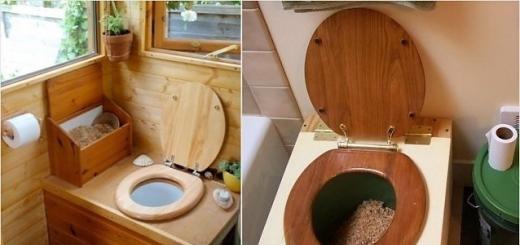There are several ways to open jars with screw caps.
From the simplest ones, such as hitting the bottom of the can with the palm of your hand and prying the side of the lid with a knife, to a variety of tape and screw keys. A blow to the bottom does not always lead to the desired result, and this method is not very suitable for women of age, picking up the side often spoils the lid, tape keys are a good thing, but it is not always possible to choose the material for the tape. It’s a pity to spoil a leather belt for this business, and various substitutes with me withstood no more than 2 - 3 months.
Therefore, I decided to make a simple and reliable eccentric wrench.
The key consists of three parts assembled into a unit and representing a body, and an eccentric. For the manufacture of body parts, 10 mm plywood, OSB, floor laminate, etc. are suitable. If none of this is available, you can buy a beech cutting board. The device of the key is perfectly visible in the photo, and there are no secrets of its manufacture. The notch on the stop is marked with the attached cover and cut with a jigsaw, followed by fine-tuning with sandpaper.

The secret of making
There is really a little "secret" to making an eccentric. It is drilled with a core drill from which the central guide drill is removed. And in order to drill evenly and accurately without a central drill, a separate plywood with a hole drilled by the same crown with a central drill is used as a guide. The hole in the eccentric is drilled 3 - 4 mm from the center of the circle. For the eccentric, I used a crown with a diameter of 40 mm.
It is advisable to paste over the recess of the stop and the eccentric with an anti-slip material, for example, a strip of rubber. Or cover with several layers of glue 88.

Well, a little bonus. To unscrew covers of smaller diameter, an insert is provided, which is made from a semicircle of the stop remaining after sawing out the notch.
Hello to all do-it-yourselfers!
And after that, I became interested in what homemade products on this topic are on the Internet. It turned out that perhaps the most popular device for opening screw caps, appearing on the Internet, is a device made of a wooden plank with an oblique saw cut, to the tip of which is attached a tape, usually made from a plastic bottle. With the help of this tape, thrown over the screw cap, the bank is opened.
True, a significant drawback of such a device is that in most cases this tape is not regulated in any way, which is why it cannot open cans with different lid diameters.
In the end, I decided to continue the experiment on making devices for opening cans with screw caps, and make a similar device. Only in my device, I decided to make a tape from a durable leather strap of adjustable length, for opening covers of various diameters.

And as a strap, I decided to use such an ownerless dog collar of a small size.

I must say that this collar is completely new and has never been used for its main purpose, although it has been hanging with us for 10-12 years. And its history is such that at one time we had a small dog for which, in fact, this collar was bought. However, they did not have time to put it on, because literally the next day, this dog died tragically, having fallen under a car. Since then, we have had other dogs, but they were all quite large, so this collar never came in handy. And that's what I decided to use.
Materials and tools
So I needed the following supplies:
Materials and fasteners:
- Wooden plank 1.2 cm thick, 4 cm wide, and 15-20 cm long;
- One screw with a press washer 4x15 mm;
- The collar itself.
- Drawing and measuring tools (pencil and square);
- Awl;
- Electric jigsaw with a saw for a figured cut;
- Electric drill-driver;
- Drill for metal with a diameter of 2.5 mm;
- Sandpaper.

Making a fixture
First, using a jigsaw, I sawed out such a wooden blank for the handle.

Then, in the upper part of this workpiece, I drilled a blind hole with a diameter of 2.5 mm, under the screw, so that the handle would not crack.

The handle itself was processed with sandpaper.
I drilled the same hole in the tip of the collar.

Then he screwed the collar to the handle, with a screw with a press washer.

Moreover, I screwed it up so that when forming a loop from the collar, there was a leather layer inside to ensure better friction between the collar strap and the can lid.

Since I will not be fixing the free end of the collar so that the size of the loop can be adjusted, this end will have to be held by hand. To make it easier and more convenient to hold, I sawed such a notch in the handle.

Now the free end of the collar will be easy to hold with the thumb of the right hand.

In addition, so that the collar was always folded into a loop, I decided to additionally make a small bracket out of wire.
To do this, I needed a small piece of wire, 1 mm in diameter, as well as a hammer and pliers.

From the wire I made a bracket, which I attached by simply hammering its tips on both sides of the upper part of the handle with a hammer.


The bracket, of course, turned out to be frail, but on the other hand, it will not have a big load on it.
And now my device is ready!
Photos of the finished device


Device test
Now it's time to test the device in action.
At first I tried to open a jar with a small diameter lid.

To do this, put a loop on the lid.

And tightening the loop, he pulled the handle to the side so that the oblique cut on top of the handle rolled along the side surface of the lid, while pressing the free end of the collar with the thumb of his right hand.

As a result, the bank opened without any problems.


Then, in the same way, I opened a larger jar with a lid.




In general, according to the test results, it can be stated that such a device is quite efficient.
However, this also revealed several shortcomings.
Firstly, due to the fact that the strap of this collar is quite narrow, it sometimes slips down when you install the loop on the cover.
Secondly, since the collar is small and its strap is rather short, opening large diameter covers leaves a very short loose collar tip so that it is inconvenient to hold it pressed into the handle recess.

Of course, these shortcomings are easy to fix if you take the strap wider and longer. You can, for example, use a piece of a waist belt or a strap from a bag as such a strap.
With proper training and accuracy, with this method, the lid is not damaged, and no additional devices are required.
Well, that's all for me! So far, everyone has simple, but convenient and useful homemade products!
Everyone uses canned food these days. Their modern version is a glass jar closed with a twist-off tin lid. Anyone who has ever opened such canned food knows that it is not easy to do it manually. It's all because of the small edges protruding from the back of the covers. They are screwed onto a jar, the neck of which is equipped with a large thread. When closed, the lid seems to be screwed into the jar.

This method of sealing has replaced the labor-intensive classic seaming lids. Agree that it is much easier. Indeed, in order to firmly and hermetically close the jar, it is enough to turn the lid on the jar with a suitable thread to the stop. No seaming machines, everything is done by hand.


On the other hand, not many people manage to open such a cover manually without damaging its edges. Today's homemade product will help solve this problem - an opener for twist-off lids.
Materials, tools
For our miracle invention, we need:- A small piece of a wooden block with a section of 20x30 mm;
- Used 3 or 5 L PET canister;
- Wooden ice cream stick;
- Several self-tapping screws with a wide hat on wood (press washer).

Let's start tinkering
The main element of our opener is a wooden block. He will work with him from the very beginning. For the convenience of processing it, the author used a vise, as shown in the photo.
We clamp the bar in a vise and cut off a fragment of 10-12 cm from it for the handle. To make the cut cleaner, it is advisable to do this with a hacksaw with a fine-toothed blade.



Next, cut off one end of the finished handle at an angle of 35-45 degrees. We clean the end with a small file or needle file.



It should turn out exactly like this.

From the side of the truncated plane, we mark a perpendicular line. We use the needle file as a ruler, and the marker for marking.

We make an incision with a hacksaw to the middle of the bar. If the groove is too narrow. It is necessary to flare it with the same hacksaw blade or a paint knife, and refine it with fine-grained sandpaper.




We cut off a strip from a plastic canister with a width equal to our bar. With a paint knife, this work can be done as accurately as possible.






It's time to use the secret weapon - an ice cream stick))

With it, we wedged a plastic tape inserted into a slot made with a hacksaw. We knock it lightly with a hammer for reliability, trying not to split the bar at the same time. We cut the protruding remains of a wooden stick with scissors on both sides.


Hello. Today I want to talk about a homemade device that greatly simplifies the process of opening jars with twist-off lids.
I'll start in order. My mistress always closes a lot of homemade preparations. There are compotes, and pickles and pickled mushrooms and all kinds of salads ... And of course, jams. Previously, for this, mainly cans were used "for seaming", but now, this type of lid is used only on large, three-liter cans. Smaller jars have been replaced with those that close with twist-off screw caps. All purchased products, such as green peas, etc., are also now usually closed with such lids ...
..Closing such lids is a real pleasure! There is no key needed! But now, to open ... After all, they close hot! And after cooling, the volume of the product inside decreases and "vacuumization" occurs - a vacuum is formed inside and the lid "sticks" to the jar.
Of course, you can just gently bend the edge of the lid with a knife and let the air inside. (On this site, I remember, there is even a description of a special device for such a process). But here, with jams, this method does not always justify itself. After all, when pouring hot jam into a jar, it will definitely fall on the edges. The hostess, of course, will wipe the “neck” of the can before closing it ... but, after all, she will wipe it, and not rinse it !!!)))). And the cover, attracted by the "vacuum", will not only be attracted, but also glued !! And often, by slightly bending the edge, the problem cannot be solved - the plastisol pad remains glued to the jam that has dried during storage, and does not let air in. You have to bend it harder, deforming the cover. And such a cover is no longer suitable for subsequent use ...
Therefore, I decided to make a key that would help open such lids ... (Without pretense, I confess that I myself would not have made it for myself. Somehow, I would have opened the jar and so ... But, why we love our women is for their "sweet impotence".)))). So I'm pretty tired of being constantly asked to open a jar!!
Initially, at the suggestion of a work colleague, I "solved the problem" by purchasing a "factory production" key. Here is this (photo from the Internet):

He solved the problem for a couple of months, although he slipped sometimes. But today, as soon as I went to the basement-workshop to work "for the soul", I was again "pulled" to open the jar!!! It turned out that the "shop plastic" broke a long time ago! And this time I decided to make a homemade strong "device", which will last for a long time!!!))))
I knew the general features of the future design for a long time. I've done something similar before in a hurry. (True, a little for other purposes!))). This was back in the days when there were no oil change centers, and I changed it myself in the car. Whoever did this knows how difficult it is sometimes to unscrew the old oil filter! So something like this happened to me - the filter did not want to turn away. There was an old toothed belt in the garage. I wrapped the filter around it, and the belt itself, in the place where it is folded, fastened it tightly with electrical tape to a wooden bar. It turned out like this:

Only that belt was toothed, and the electrical tape was blue !!!)))).
With this tool, I easily unscrewed the filter. It worked like this:

Only instead of a can of paint there was a filter, and the electrical tape, I repeat, is BLUE !!)))))
And even though I made this device for one-time use, it lay in my installation pit for many years, and made it easier to work many times!
And now I decided "not to reinvent the wheel", but to do it "on the knurled".
But a kitchen is a kitchen. There is no place for trees here. And therefore, I decided to do it according to the same principle, but without a tree ....
So, I needed:
1. Flat (poly V-ribbed) drive belt from a car.
2. A cut of a railing ("furniture") chrome-plated pipe with a diameter of 16 mm.
3. Plastic plug for this pipe.
4. Blind rivets.
5. Shrink sleeve (optional).
6. A piece of steel corner 45 by 45 mm. (This one came to hand)))).
Set of tools- minimum: angle grinder, drill, riveter, hammer, technical hair dryer (if thermocambric is used, which is not necessary).
First of all, I started making the handle. I decided to make it from trimming a chrome tube. I often use it in my homemade, so I always have a trim:

I flattened its edge in a vise, after wrapping it with electrical tape so as not to "pokatsat" ... (As it turned out later - in vain.)))):


Since the diameter of the tube is small (and even smaller in a flattened state), and its end is not able to provide the necessary stop, I decided to provide it with an additional stop-lever. I made this part from an equal-shelf corner with a 45 mm shelf. (It can be less. It’s just that such a piece was lying in plain sight and was the first to fall under the arm!))))

It was from him that I cut off a piece of the width I needed:

What width exactly? ... And here is this one:


Then, with the help of a hammer, he slightly bent one of the shelves:

How much exactly did he bend ???... But for so much:

(When making homemade products, I often do without drawings and measurements, but simply use the "applied method". This is when I applied it - and looked at exactly what size I need!)))))
(Now, by the way, I noticed that this hammer was also once made by myself. I cut it out of the square and welded the armature, on which I pulled the handle from some old broken Chinese crank ... Pay attention - between the handle and the head of the hammer dressed all the same, my favorite, railing tube))))))

Well, God be with him, with a hammer ... Let's continue ...
I processed the corner with an emery-petal circle and painted it from a spray can. (At the same time, in order to speed up the drying process of the enamel at times, I heated the blank itself to a hot state with a hair dryer, and carefully warmed the can "in a water bath." ).
And, nevertheless, it takes some time to dry, and for the time being I started making a loop.
I had such a V-ribbed drive belt from a car lying around:


The belt is definitely not new. Simply, the car mechanic who changed it put the removed belt into the package. (They always do this). From it I cut off a piece of the desired length.

Which one exactly? ... Yes, here is such a one)))):

I washed the resulting segment from technical dirt with hand washing paste. And then some dishwashing liquid...
After that, I tightly wound it with electrical tape. (Again, there was no blue one ... It's a pity! It would be stronger))))

By this time, the enamel on my corner had dried:



I inserted it into the flattened end of the tube:

And I drilled two holes with a drill, with a diameter of 5 mm:

With the same drill, I drilled a hole in the belt:

Using pop rivets of the right length, I attached the strap to the handle. I did it in the following way: first I riveted one rivet. After that, I aligned the belt, drilled another hole in it, and secured it with a second rivet. At the same time, under the rivet heads, for a more reliable fastening of the belt, I placed enlarged M5 washers, which were found in my stocks:



And at this stage, I really didn’t like the appearance of this mount ...))) .. I solved this problem with the help of a large-diameter heat-shrinkable cambric, the stocks of which I also had. First, I cut off and rounded all the protruding parts of the belt with a technical knife:

I cut off a piece of the desired length from the cambric. (I defined it, again, by the "applied method"))))
Can't open a screw-top jar and the man isn't around? Do not want to spoil the lid with a knife, but do not have enough physical strength to unscrew it?
Twist-top jars are very helpful in canning, but when opened, they behave very unpredictably. Theoretically, with a little effort, the lid should unscrew freely. But this does not always happen. Any hostess has her own stock of secrets and wisdom for solving this problem, however, we will also give you a couple of tips.
How to open the screw cap
To begin with, try to degrease as much as possible not only the jar and lid, but also your own hands. You can try to increase friction by putting an elastic band on the lid or wrapping it with cling film.
Rubber gloves can also help you - they will reduce the slip of your hands on the jar. With the same success, you can use a regular kitchen towel.
Then put into practice the knowledge of physics - try to twist not the lid, but the jar. In this case, rotate the lid counterclockwise, and the jar clockwise.
Another reliable method is to heat the lid - put it in hot water for a while (holding the jar upside down) and then try to open it.
You can try to scroll the cover with a sheet of coarse sandpaper. Put the sandpaper on the cover, abrasive down and unscrew.
With a wooden or plastic knife handle, lightly tap the lid around the circumference - after that it should open quietly.
An interesting male way of opening a screw cap was sent by our regular reader and commentator Egor Serov:

You can try the next option - putting the jar lid down, drip a few drops of vegetable oil between the lid and the neck of the jar. After waiting until the oil spreads evenly (about 15 minutes) and gets into the smallest cracks, open the jar.
There is another way - to roll the lid along the edge of the table, pressing on it. The jar should be outside the table, and the lid on the edge of the table. At the same time, the lid slightly bends, a characteristic cotton is heard and that's it! Lid can be used!
Some housewives have a wonderful way of opening such lids - turn the jar over, lightly tap the bottom with a light cotton and open.
Still, the best fail-safe method is to pry off the lid with a can opener. However, if you do not want to ruin the lid, then this method will not work for you - after all, the main advantage of a screw cap is that it can be used repeatedly, and in this case it will be irretrievably lost.
If these methods do not help you, and each opening of a jar turns into a real torment, then the benefits of civilization will help you. For many years, people all over the world have been using a special tin wrench to open jars with screw caps. The relatively low price and ease of use of this universal wrench (suitable for different cap diameters) will save you from this problem forever.

Do not forget about the main tool for solving such problems - strong male hands will always help in such a situation and make you feel like a weak and tender woman.










